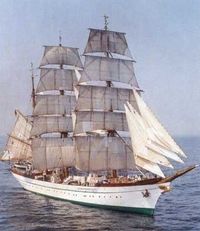Fort Fitzgerald & Fort Smith & Wood Buffalo Park
This time our propsaver did not save the prop, the reef was on the starboard side ! But we have a view spare props left...
Fort Fitzgerald on the Slave River
The old Fort Smith
Fort Smith is a town in the southeastern end of the Northwest Territories, part of the South Slave Region. It is about 300 kilometers southeast of Yellowknife and has a population of over 2,300 people, most of whom are First Nations. In the past, Fort Smith was a transportation town, and goods were transported to and from along the Mackenzie River via Fort Smith. The building of the Mackenzie Highway, however, put an end to this.
Today, the town sustains itself through tourism. Many travelers come to kayak the rapids along the Slave River. Fort Smith is a town in the southeastern end of the Northwest Territories, part of the South Slave Region. It is about 300 kilometers southeast of Yellowknife and has a population of over 2,300 people, most of whom are First Nations. In the past, Fort Smith was a transportation town, and goods were transported to and from along the Mackenzie River via Fort Smith. The building of the Mackenzie Highway, however, put an end to this. Today, the town sustains itself through tourism. Many travelers come to kayak the rapids along the Slave River.
Annie & Clayton Burke / 53 portage Ave. Fort Smith
Tel: (867)872-2060 Fax:(867)872-2401
Filming the Pelicans on the Rapids of the drowned...
It is fun to watch the Pelicans...
The Slave River, 561 km in length, connects the Peace River and the drainage from Lakes Claire and Athabasca to the Great Slave. The course of the river provides spectacular views of the landscape ( a 2.1 billion year old geology), wildlife that includes the northernmost white pelican rookery, rich fauna and sandy beaches, and several islands.
The rapids of the Slave River lie on the Alberta/NWT border, stretching a 25 km length between Fort Fitzgerald and Fort Smith. As the rapids flow to the north, the drop in elevation is twice Niagara Falls' height.
We have some very good HDV footage of the Pelicans...
The American White Pelican (Pelecanus erythrorhynchos) is a very large (50"–70") white bird with black wing tips and a long, wide orange bill. They have a wing span of approximately 3 m . They are graceful in flight, moving their wings in slow powerful strokes.Unlike the Brown Pelican, the American White Pelican does not dive for its food. Instead it practices cooperative fishing. Each bird eats more than 4 pounds of fish a day, mostly carp, chubs, shiners, yellow perch, catfish, and jackfish.White Pelicans nest in colonies of several hundred pairs on islands in remote brackish and freshwater lakes of inland North America. The most northerly nesting colony can be found on islands in the rapids of the Slave River between Fort Fitzgerald, Alberta and Fort Smith, Northwest Territories. About 10-20% of the population uses Gunnison Island in the Great Salt Lake as a nesting ground. The female lays 2 or 3 eggs in a shallow depression on the ground. Both parents incubate.
The Wood Buffalo National Park
At 44,807 km2, Wood Buffalo National Park is Canada's largest national park and one of the largest in the world. The park was established in 1922 to protect the free-roaming bison herds of the area. Today, the park supports and protects many unique natural and cultural resources, from diverse ecosystems and rare species to the traditional activities of Aboriginal residents. As a remote wilderness park and World Heritage Site, Wood Buffalo National Park attracts Canadian and international visitors who wish to experience and learn about the unique cultures, landscapes and wildlife of the boreal north.Within Canada's system of national parks, Wood Buffalo National Park protects representative examples of the Northern Boreal Plains, Southern Boreal Plains, and Northwestern Boreal Uplands. The majority of the park is within the Northern Boreal Plains natural regionInternational Significance. In 1983, Wood Buffalo National Park became the eighth site in Canada to be granted World Heritage status by UNESCO (United Nations Educational, Scientific and Cultural Organization). Inscription on this list confirms the exceptional universal value of a cultural or natural site which deserves protection for the benefit of all humanity. The outstanding characteristics of Wood Buffalo that led to its designation include:.one of the largest free-roaming and self-regulating bison herds in the world the last remaining natural nesting area for the endangered whooping crane
the Peace-Athabasca Delta, one of the largest inland freshwater deltas in the world some of the finest examples of gypsum karst landforms in North America
unique salt plains vast undisturbed expanses of boreal wilderness.
After 4 days of searching and over 500Km driving in the Wood Buffalo Park
and many, many hours of waiting in clouds of Moskitos, Blackflys and Horseflys, we finally found a whole herd of over 100 Buffalo or better they found us...
I was filming some Birds on a little pond, and suddenly a whole herd came down to drink.
Oh man,
we will never forget this moment !!!
Wood bison (Bison bison athabascae )
This animals are huge.
Wood bison (Bison bison athabascae )
North American bison are an endemic keystone species of northern Canada as well as the dominant species of the largest biome found on the continent. Wood bison are a recovering subspecies of the North American bison. This mammal, which is the largest terrestrial animal in Canada, has faced extinction twice in the past hundred years. Since it was downlisted from the endangered category in 1988, the wood bison is currently classified as a threatened species.
The latter is likely to become endangered if limiting factors leading to the threatened status are not reversed. Therefore, if we want to reduce their risk of extinction, we need to put efforts into conservation.
Wood buffalo (Bison bison athabascae) are close relatives of the United States' plains buffalo (Bison bison), but larger and with darker coats. A significant number of Canadian wood buffalo survived, and the descendants of the herd remain wild, thanks to an 1893 law prohibiting buffalo hunting in Canada.
The wood bison is characterised by:
Dark brown coat
Massive head
High hump on its large shoulders
Long shaggy hair on its shoulders and front legs
Short legs with rounded hooves
Short black horns - curved inward on males and straight on females
Males are larger than females and can measure from 3 to 3.8 meters in length. Their height ranges from 1.67 to 1.82 meters at shoulders and their weight from 350 to 1000 kilograms.Wood bison can live up to 40 years.
With the exception of humans, wolves and bears are the main predators. The predators preferably attack bison herds with calves. If a female is heavy and in good condition, her offspring has an increased chance of survival.
Wood bison live in groups of variable size and are usually at their largest in the summer. Females tend to gather in larger groups so as to reduce the chances of predation on their calves. Vigilance varies with group size, where as the net vigilance (i.e. for the entire group) is increased and the per capita vigilance (i.e. for each individual in the group) is decreased in large groups.
Continue with: Hay River
Only those who risk going too far, will discover how far they can go!
Expedition in USA, Alaska & Canada, Scandinavia with folding boat, motorboat, catamaran, motorcycle, off-road vehicle, bicycle ...















